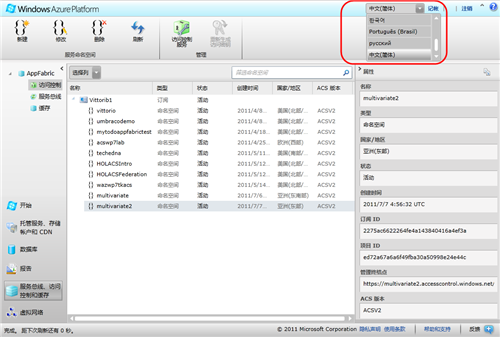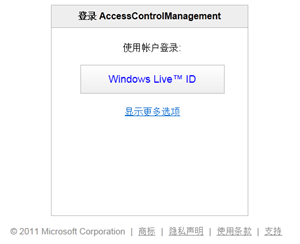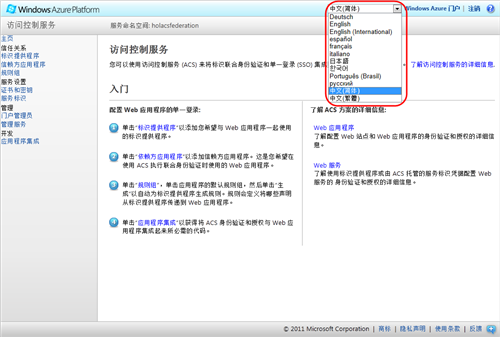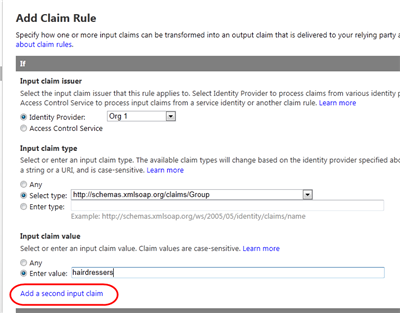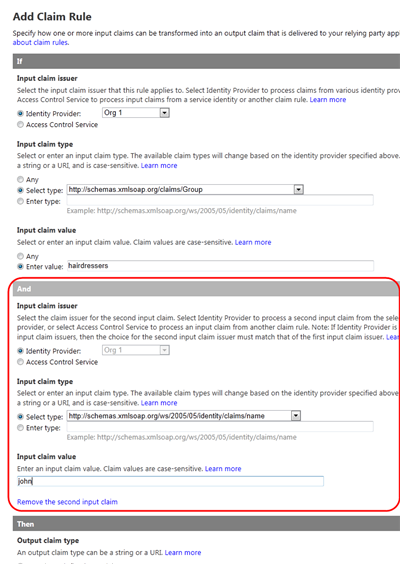New in ACS: Portal in Multiple Languages, a New Rule Type… and Wave Bye-Bye to Quotas
Big news in ACSland today! There few new key features that - I am sure – many of you will welcome with a big smile.
As usual, for the full scoop take a look at the announcement and the release notes; here I’ll just give you few highlights & customarily lighthearted commentary.
The Portal Comes in 11 Languages
Riding the wave of the general localization effort sweeping the Windows Azure portal, the ACS portal can now entertain users in 10 extra languages, such as Japanese, Chinese (simplified and traditional), Korean, Russian, Portuguese, Spanish, German, French and even Italian ![]() .
.
Switching it is pretty trivial, to the point that I am daring to switch to Chinese without (too much) fear of not being able to revert to English ![]() . Just pick the language you want in the dropdown on the top right corner, and the UI will switch immediately. Also note the URL (in my case it moved to https://windows.azure.com/Default.aspx?lang=zh-Hans).
. Just pick the language you want in the dropdown on the top right corner, and the UI will switch immediately. Also note the URL (in my case it moved to https://windows.azure.com/Default.aspx?lang=zh-Hans).
From that moment on, everything will be localized accordingly: for example if I invoke the management portal for one namespace, I get the HRD page localized accordingly:
And of course, the portal itself is now fully localized:
Note that I can override the language settings directly from the ACS portal, as highlighted in the image above.
Biographic note: I always have a lot of fun checking out the Italian versions of the software I use. The reason is that everybody have a different threshold about what should be translated and what should remain in their original formulation (why translating IP to “provider di identita’” but leaving RP as “relying party”? (or even why keeping “provider” but translating “identity”?)), and for expats like myself that threshold is often 0 (as in “do not translate at all”). Mismatches in expectations lead to those "benign violations” that McGraw claims constituting the basis of humor ![]() but I digress: ignore my pet peeves, I am sure that having the portal available in multiple languages will be of enormous help for making ACS even easier to use. Good job guys!
but I digress: ignore my pet peeves, I am sure that having the portal available in multiple languages will be of enormous help for making ACS even easier to use. Good job guys!
Quotas Are No More
Ah, this one is as simple as it will be appreciated, I have not the slightest doubt about it.
Some of you occasionally stumbled on quotas: deliberate restrictions which capped the maximum number of entities (rules, trusted IPs, RPs, etc etc) that could be created within a given namespace. Well, rejoice: those restrictions are now all gone. Have fun!
Rules Accept Up To 2 Input Claims
Here I risk throwing myself in a somewhat lengthy explanation, which I know many of my colleagues will deem unnecessary (as in “why does he always take hours to get to the point?!”). In order to preempt their complaints, here there are the sheer facts about the new rules:
From this release on, you have the option of specifying up to two claims as input for claims transformation rules. If claims triggering both input conditions are present (logical AND), then the rule will trigger. The input claims must both be from the same identity provider, as there is no flow that would allow ACS to gather claims from multiple sources at once; alternatively, they can mix one identity provider and ACS itself.
That’s all very straightforward. When you create your rule, specify your input claim conditions as usual; you’ll have the chance of adding a second input claim, by clicking on “Add a second input claim” as shown above.
That opens up a new area in the UI, where you can specify the details of the second input claim. It’s that easy! Note that only newly created rules will allow a second input claim, and that rules created via the Generate command won’t have the second input claim either.
One application of this new rule type is pretty obvious: you can express logic which depends from more than one factor (two, in fact) in the input token. As in “you get to be in the ‘Gold’ role only if you are in the group ‘Managers’ AND in the group ‘Partners’”, which was impossible to express before introducing the new rule type. Unless you enlist in the process the administrator of the IP and you convince them to add the rule in THEIR system directly at the origin, but that would be cheating.
Another application is slightly less obvious: it is the chance of composing the current input with decisions taken in former iterations. I know, that’s not especially clear ![]() that’s why I am throwing myself in the lengthy explanation in this other post, which is totally optional.
that’s why I am throwing myself in the lengthy explanation in this other post, which is totally optional.
That’s it folks! Once again, don’t rely on this unreliable blog and read for yourself about the news in the announcement and the release notes. I am sure you’ll surprise us with real creative uses of those new features now at your disposal!
